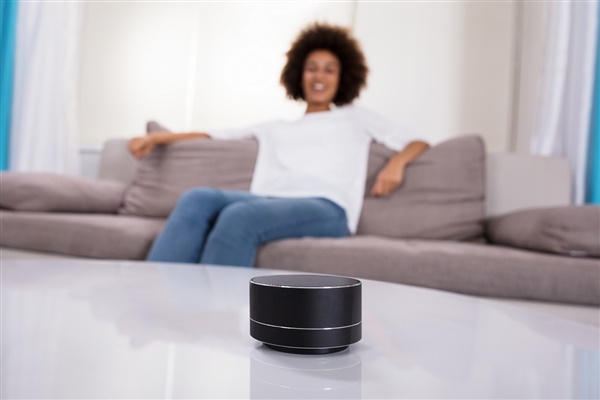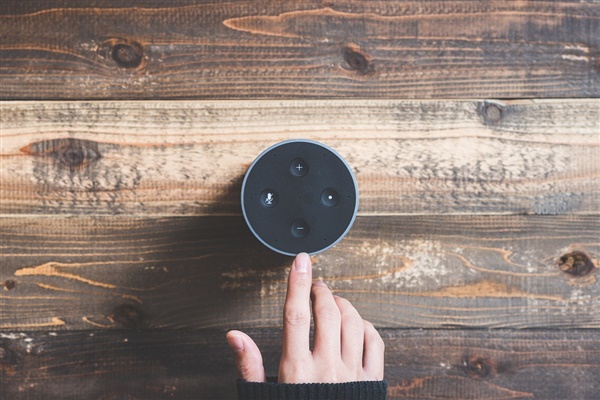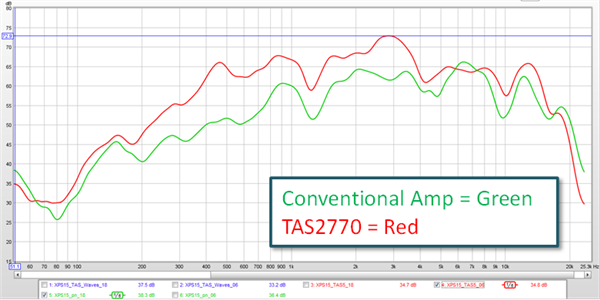SSZT700 june 2018 TAS2557 , TAS2559 , TAS2560 , TAS2562 , TAS2563 , TAS2564 , TAS2770
Smart speakers are ingeniously helpful devices, providing weather reports, ordering food or playing a favorite song. As consumers find more ways to use virtual assistants, these devices are being added to more rooms, and the size of the device is shrinking to make them less conspicuous.
Unfortunately, there is a direct relationship between speaker size and output power. As smart speaker form factors shrink, so does speaker size. And when the speaker shrinks, so do the sound pressure levels that the speaker can generate, because it can no longer handle as much power. Smaller speakers mean quieter systems, but smaller speakers may also reduce intelligibility, with corresponding reductions in end-user satisfaction since they may not be able to hear the smart speaker’s response from across the room (Figure 1).
 Figure 1 A smart speaker can hear you
across the room, but can you hear it?
Figure 1 A smart speaker can hear you
across the room, but can you hear it?Meeting a preferred price-point level can also lead to the use of less capable, smaller speakers. Put another way, consumer desire for smaller, attractive, lower-cost smart speakers has the unintended consequence of reducing audio output levels and audio quality.
What options are available to increase the output power in smaller speakers?
| Learn more about our smart speaker solutions | |

|
Get big sound from small speakers with Class-D Smart Amps. |
Until now, a continuous power design approach matched the audio amplifier to the performance envelope of the speaker. This approach provides just enough power to create low and high frequencies without damaging the speaker. But it is also what causes sound to decrease when the speaker size decreases. Smaller speakers, smaller sound.
One solution to the continuous power design trap is to use speaker protection amplifiers, which can increase the loudness and audio quality without changing the industrial design, the speaker size or necessarily increasing speaker cost (Figure 2).
 Figure 2 Speaker protection amplifiers
get bigger sound from smaller speakers
Figure 2 Speaker protection amplifiers
get bigger sound from smaller speakersWhy worry about the speaker? Unlike many consumer electronics, a smart speaker is built for the purpose of audio capture and audio playback. The most important part of the audio playback system is not the amplifier, but the speaker.
A speaker protection amplifier helps improve speaker performance by modifying the electrical signal in real time to bring out the full capacity of the speaker. An audio speaker is a motor, which converts electricity into magnetically generated movement that moves a speaker diaphragm back and forth fast enough to create audible tones.
A speaker moves air at low frequencies and dissipates heat at high frequencies. But too much of either can cause damage. At low frequencies, the enemy is over excursion. That’s when the speaker’s voice coil moves too far forward or backward and damages itself or the speaker diaphragm. High frequencies can damage speakers by generating excessive heat when electricity converts into high-speed movement. And too much heat causes all sorts of damage: The adhesives in the speaker melt, which can cause structural failure. The magnet in the voice coil can demagnetize. The voice coil can overheat and become less compliant.
To increase performance without damage, speaker protection amplifiers employ a model of the speaker in addition to a sophisticated signal analysis to momentarily provide peak power up to five times the speaker’s nominal rating. These algorithms apply peak power to speakers delivering a 9 dB to 12 dB increase in output, which is about two to three times louder than a conventional amplifier with the same speakers. See Figure 3 which shows the improvements across the frequency response of a typical smart speaker. To learn more about how speaker protection algorithms work, check out the Smart Amp Tuning Guide.
 Figure 3 Speaker protection amplifiers
double the loudness of conventional amplifiers
Figure 3 Speaker protection amplifiers
double the loudness of conventional amplifiersThe model and signal analysis also enable the algorithms to compensate for problems with the speaker’s frequency response at nominal and higher output levels, which helps improve audio quality and intelligibility.
Speaker protection amplifiers are a proven technology used in millions of smartphones, thermostats and laptop computers. Check out TI’s Smart Amps speaker protection amplifiers to see how they can help solve your smart speaker challenges.
Additional Resources
- Learn more about TI’s PurePath™ Console software.
- Start designing now with the TAS2770 evaluation module (EVM).
- Download the “Overview of system-level protection in Class-D audio amplifiers” white paper.
- Check out the Stereo Evaluation Module Reference Design of the Digital Input, Class-D, IV Sense Audio Amplifier.
- Explore additional guides to jumpstart your design:
- Learn how to start your audio design with the Smart Amp Quick Start Guide.
- Start prototyping quickly with the TAS2770 Stereo Evaluation Module.
- Read about tuning basics in the Smart Amp Tuning Guide.
- Check out TI’s industrial solutions portal.